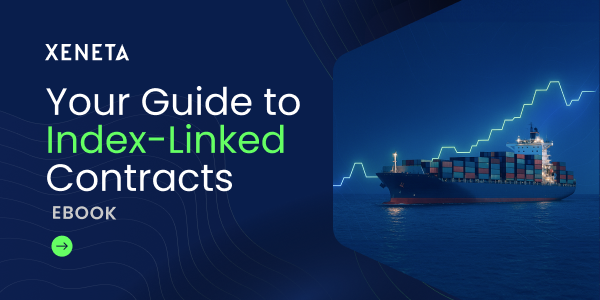Alliances and continued diversions to avoid the Red Sea are two of the biggest factors shaping ocean container shipping right now. And in a recent webinar, Xeneta’s Chief Revenue Officer, George Thomas, and Senior Shipping Analyst, Emily Stausbøll, discussed exactly how they’re shaping the current market — and what steps you can take to reduce the risk of disruption.
Watch the full webinar, Gemini, the Red Sea & the Fine Print: What’s Really Driving Ocean Freight in 2025, on demand now. Or read on for the highlights.
The Gemini Alliance is driving higher schedule reliability
At the 2024 Xeneta Summit, Hapag-Lloyd CEO Rolf Habben Jansen and Maersk VP Kenni Skotte discussed the ambition behind the Gemini Alliance: a long-term operational partnership launched on February 1, 2025, to deliver fast, flexible, and reliable shipping. A key promise – 90% schedule reliability – stood in stark contrast to the then global average of just 53%.

While Global schedule reliability today sits just under 60%, it still falls short of the pre-pandemic average, which sat closer to 80%. To Stausbøll's point, this represents 'many, many years of poor schedule reliability', and while significantly better than the lows of 30% we saw during the pandemic, 'we're still far off what can be considered a good service level".
And it’s not just an issue of ships arriving late. As you can see from the black line, the average delay is around 5 days — so while many ships will have shorter delays, others could be far longer. To help shippers plan with greater accuracy, the Xeneta platform shows both the announced and actual transit times* — the time it takes for goods to travel from origin to destination – for the various carriers and tradelanes.
Adopting a hub and spoke model which relies on fewer direct port calls, the Gemini Alliance came to the market with an offering that promised to prioritise high reliability. And it appears to be working.
With data from its first month of operation, Hapag-Lloyd is already reporting early success with the Gemini Alliance – showing an average schedule reliability across all alliance port calls of 90.3%, nearly 40 percentage points above the global average. So while it is early days and more data is required to create a full picture, currently, the start looks promising for the Gemini Alliance. This is despite all the recent disruption and in the face of scepticism from freight forwarders and shippers when first announced.
*One thing to note, on the ports where Hapag-Lloyd and Maersk have direct calls, data is showing they have a much lower transit time, but this doesn't include the transhipment that would be required for many other ports – which is important when you consider that more shippers will be seeing their containers moved and being transhipped under the Gemini Alliance than would have previously been the case.
The Red Sea remains a complex picture
The number of ships, particularly smaller vessels, returning to the Red Sea and Suez Canal is rising. In fact, CMA CGM Osiris sailed a 15,000 TEU container ship through the Suez Canal a few weeks ago, representing the biggest containership since March last year, on its journey from Singapore to Alexandria, Egypt. However, as Stausbøll notes “importantly, it had a French military escort, so this is not a return to normal operations. This was a special circumstance, but special guarantees are still needed”. The Israel-Iran situation also added another layer of complexity, threatening the safety and stability of the area, including risk to ships being stranded.
The Red Sea is one of the key factors that has kept rates high for the past 18 months, with longer routes around the Cape of Good Hope pushing up TEU-miles demand and bringing it closer to fleet capacity.

While a return to the Red Sea would lead to a large drop in freight rates, we would potentially see heavy congestion at first. This is one of the reasons carriers are reluctant to return. Once ships do return to the Red Sea, there will be a period of about a month where ships that have been around Africa and the first ships rerouting back through the Suez Canal will arrive in Europe at the same time — putting a lot of pressure on already stretched European ports.
The more back and forth there is on a decision to return to the Red Sea, the longer this congestion will continue so carriers are keen to wait for the right time to go back, when Red Sea routes can remain operational long term.
“ If you're signing a 12-month contract or starting to look into your rates for 2026, the Red Sea is one of those things that you need to bear in mind as it might change significantly. And that’s where it becomes important to understand what kind of contract you have, where the market is going, and how you're protected or exposed to those risks.”
Emily Stausbøll, Senior Shipping Analyst
Understanding the fine print of ocean freight promises
Sometimes, what you sign coming out of your tender doesn’t match what’s delivered in practice — so it’s crucial to watch out for a few key things when finalizing new agreements.
Make sure you understand what ‘guaranteed’ really means in your contract. Will your cargo get shipped no matter what? Or are there still some risks that will cause your freight to be rolled? Protect yourself against hidden surcharges and change clauses. And ensure you fully understand who bears the risk of delays and cancellations.
Of course, these common pitfalls are easier to avoid if you have access to timely, accurate, and real data.
“ We live in very volatile times, both on the demand side and on the supply/capacity side. So we see these big spikes in pricing. And I think it really shows the need for real time visibility to understand how to capture cost savings in the market, protect yourself from cost rises, and equally — if not more importantly — how to secure your supply chain and make sure you can get the reliability that you need.”
George Thomas, Chief Revenue Officer
Three techniques to help you weather freight volatility
- Scenario planning: Volatility is here to stay, and while future events can’t be predicted, planning for likely freight scenarios can help you stay ahead of disruptions. As we've seen with recent tariffs and geopolitical events, full visibility into micro-levels impacts, routing options, suppliers, and costs, enabled shippers to deliver the supply chain resiliency they needed to pivot and keep goods moving.
- Flexible routing: Being able to shift your routes and engage different suppliers quickly and flexibly gives you the best chance of getting your goods exactly where they need to be, regardless of what’s going on in the world.
- Better visibility tools: If you understand exactly what’s going on in the world in real time, you can make the right decisions at the right time – shifting your routes or implementing an appropriate scenario plan exactly when it makes sense to do so.
What’s next for ocean freight in 2025?
With volatility showing no signs of slowing, the second half of the year will demand sharper planning, greater flexibility, and real-time insights. Whether you’re navigating shifting trade patterns, reacting to new disruptions, or rethinking your procurement strategy, the 2025 Ocean Outlook: Mid-Year Update is your guide to what’s unfolding – and what to do about it.
Header image courtesy of Marine Benchmark.
%201.png)







